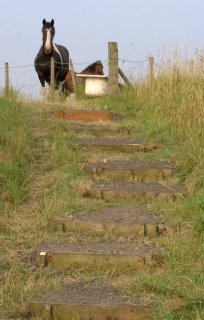
This is a view of the Valley from the Fleet. The short grass is the work of the resident rabbit family. The green foliage on either side is bramble, the home of the rabbit family. The black dog in the foreground is Holly, friend of the rabbit family!!
It looks like a bit of a desert, but in fact it is the home of quite a lot of the rarer plants, and insects. Worth a visit as you can access the ridge on the right which gives very good views over the marsh and also out to sea.






